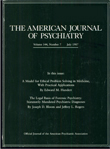This manual on pain management would be useful for the primary care physician as well as for psychiatrists, anesthesiologists, and other specialists who treat patients with chronic pain. All of the topics are treated in an overview style, but the scope of pain syndromes and treatments discussed is truly encyclopedic. Topics vary from pediatric pain to intraoral pain to an excellent review of regional pain block techniques. Even in an era of managed care with the emphasis on limiting referrals, no one physician can do all of the treatment protocols described in this book. It is useful for practicing clinicians to know what all of the options for treatment are, however, so that they will know what possible referrals to make for an individual patient. When reviewing an individual's records, a clinician's familiarity with this book can help determine if all applicable modalities have been appropriately applied.
An additional benefit of the book is the how-to format, which is very useful for the hands-on clinician. Of particular interest is the chapter on nonsteroidal anti-inflammatory agents. Rather than dealing in-depth with aspirin and then only alluding in a general way to the other nonsteroidal anti-inflammatory agents, the chapter goes into detail regarding about 11 different types and makes distinctions among them regarding potency, indications, and such important side effects as gastrointestinal distress.
Another excellent chapter is Dr. McDonald's on pelvic and lower abdominal pain. Many general handbooks on pain overlook this very important problem or mention a few words about obstetrics and gynecology without going into detail about etiology and treatment. Dr. McDonald is to be commended for his ability to discuss physical causes of lower abdominal and pelvic pain while strongly emphasizing the psychological concomitants to these syndromes and the need to establish a bond of trust between the physician and patient. The only criticism one could make about this chapter is that the author does not acknowledge the possible contribution of the psychiatrist, as well as the psychologist, to the treatment of these patients.
Another important aspect of the book is that it is divided into two sections. The first section, Therapeutic and Diagnostic Approaches, includes information on therapeutic and diagnostic procedures in evaluation of the pain complaint and treatment. Acute pain management, regional anesthetic techniques, pharmacological management, and other approaches are discussed. The second section, Pain Syndromes, deals with the constellations of pain complaints that are frequently encountered in clinical practice. Again a panoply of treatment options is offered.
As an example, the contribution on herpes zoster and postherpetic neuralgia reviews the use of narcotic analgesics, tricyclic antidepressants, anticonvulsants, capsaicin, blocks, surgery, and various forms of electrical stimulation. Again, one physician would not be applying all of these techniques for an individual patient, but in describing all of the options that meet current standards of care, the book allows the managing physician to direct patient care in an appropriate and logical sequence. Any physician, either generalist or specialist, who works in the area of pain management will find this book a most useful addition to his or her library.

